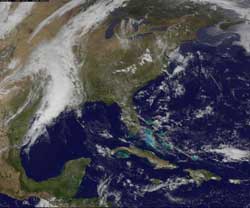NASA sees more severe weather over eastern Texas, Oklahoma

NOAA's GOES-13 satellite captured a visible image of the clouds associated with the stalled front over eastern Texas and Oklahoma on March 20, 2012 at 1731 UTC (1:31 pm EST). Ironically, the clouds look almost like a giant funnel. Credit: NASA/NOAA GOES Project<br>
NASA's Aqua satellite and NOAA's GOES-13 satellite have been providing infrared, visible and microwave images to forecasters of the stalled frontal system.
On March 20, a flood warning was in effect up and down the eastern sides of Texas and Oklahoma, including Dallas and Fort Worth, Texas. The National Weather Service posted a flood warning for the double cities because of heavy rainfall over the last 36 hours. More isolated thunderstorms are expected to develop late afternoon and evening, generating more heavy rainfall, lightning and small hail.
When NASA's Aqua satellite flew over the low pressure area on March 20 at 0753 UTC 34:53 a.m. EST), the Atmospheric Infrared Sounder (AIRS) instrument onboard captured an infrared image that showed cloud top temperatures in the frontal system. The strongest thunderstorms, heaviest rainfall and coldest cloud top temperatures (around 220 Kelvin/ -63.6 F/-53.1 C) appeared as a giant wedge over the region.
NASA's Goddard Space Flight Center in Greenbelt, Md. uses data from the National Oceanic and Atmospheric Administration's (NOAA's) GOES-13 satellite's and creates images and animations. NOAA's GOES-13 satellite captured a visible image of the clouds associated with the stalled front over eastern Texas and Oklahoma on March 20, 2012 at 1731 UTC (1:31 p.m. EDT). Ironically, the clouds look almost like a giant funnel.
Media Contact
More Information:
http://www.nasa.govAll latest news from the category: Earth Sciences
Earth Sciences (also referred to as Geosciences), which deals with basic issues surrounding our planet, plays a vital role in the area of energy and raw materials supply.
Earth Sciences comprises subjects such as geology, geography, geological informatics, paleontology, mineralogy, petrography, crystallography, geophysics, geodesy, glaciology, cartography, photogrammetry, meteorology and seismology, early-warning systems, earthquake research and polar research.
Newest articles

A new look at the consequences of light pollution
GAME 2024 begins its experiments in eight countries. Can artificial light at night harm marine algae and impair their important functions for coastal ecosystems? This year’s project of the training…

Silicon Carbide Innovation Alliance to drive industrial-scale semiconductor work
Known for its ability to withstand extreme environments and high voltages, silicon carbide (SiC) is a semiconducting material made up of silicon and carbon atoms arranged into crystals that is…

New SPECT/CT technique shows impressive biomarker identification
…offers increased access for prostate cancer patients. A novel SPECT/CT acquisition method can accurately detect radiopharmaceutical biodistribution in a convenient manner for prostate cancer patients, opening the door for more…




















